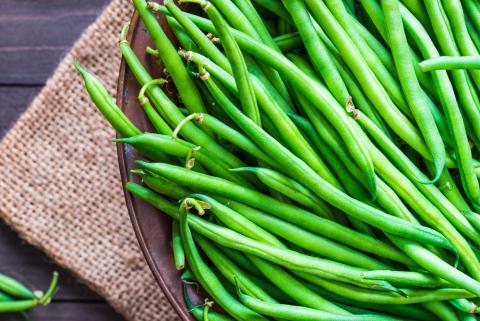
Green beans are a member of the family Fabaceae ⁄ Leguminosae, commonly known as the Pea family of the genus Phaseolus L. or bean, containing the species as identified by the United States Department of Agriculture (USDA) as Phaseolus vulgaris L. or kidney bean. The plant is native to the Americas and was documented in Mexico, parts of Central America, and regions of South America. It is currently a worldwide staple and lends itself to countless recipes and ethnic cuisines—and it can even be juiced. The vegetable is listed as belonging to both bean and legume families and rightly so because studies have proven that green beans contain similar vitamin, mineral, and other beneficial substances as beans and legumes and are known to lower the risk of developing chronic diseases. A green bean by any other name is still a green bean because it has many different nomenclatures like snap beans, string beans, and wax beans.
Green beans are tender, firm, elongated bean pods that have yet to mature. The cylinder contains immature beans and green beans are grown in many varieties that range in color from hues of green to yellow. They can be divided into two groups: pole beans that need to be supported and bush beans that grow without support.
Health Benefits of Green Beans
Green beans are rich in nutrients that include vitamins B1 (thiamin), B2 (riboflavin), B3 (niacin), B6 (pyridoxine) and B9 (folic acid), as well as vitamins A, C, and K. The minerals that are found in green beans include calcium, magnesium, potassium, phosphorous, sodium, and iron. Other beneficial substances contained in the vegetable are fiber and fatty acids.
There are many health benefits in green beans. Rich in fiber, green beans are an excellent food for those on a weight loss diet as fiber prevents the development of body fat. It also maintains a healthy digestive system, bulking up the stool and preventing constipation. Its rich chlorophyll content lessens the risk of developing cancer. The flavonoids present in green beans help to keep the cardiovascular system healthy and functional.
Other health benefits of green beans include a strong and healthy skeletal system as vitamin K is essential to the production of calcium and maintains proper mineral absorption. Of the many benefits of vitamin C found in green beans is the maintenance of a strong immune system and keeping the skin and hair healthy. Its vitamin A maintains a healthy ocular system and the presence of folic acid benefits prenatal heath.
Growing Green Beans
Green beans are a popular addition to the garden. As mentioned, they come in two groups, pole and bush; the pole bean is a vining plant that needs a trellis or other means of support and can grow as high as fifteen feet. Plant pole bean seeds three inches apart after the last frost.
The bush bean stands independent and will spread to approximately two feet around and must be planted from seed two inches apart after the last frost and not started indoors as they may not survive transplanting.
To have green beans throughout the summer plant seeds every two weeks in well-draining soil. It is also advised to mulch the plants. Use light nitrogen fertilizer to get a better yield and harvest the pods when they are still immature by snapping or cutting off the stem—and be sure not to tear them off.
How To Eat Green Beans
A versatile food, green beans can be used in many dishes that include sides, salads, stews, soups, and casseroles. One of the most popular recipes is the Three Bean Salad and another dish is green beans sauteed in butter with almonds. Green beans can be pickled and used as a relish; the waxed variety make a colorful addition to salads when they are combined with the purple and green varieties.








